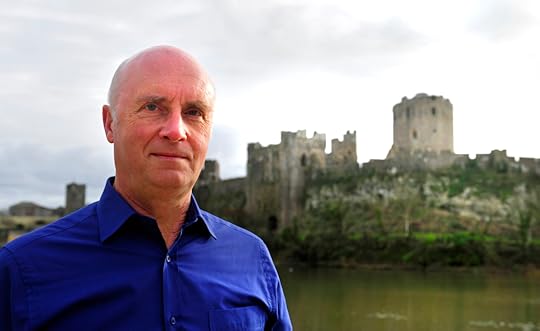Pam Lecky's Blog, page 16
July 28, 2021
Guardians at the Wall: Tim Walker

We all love a bargain – pop over to Amazon to check out the Kindle Countdown Deal on this great historical fiction novel – only 99p for a limited time!
GUARDIANS AT THE WALL
A group of archaeology students in northern England scrape at the soil near Hadrian’s Wall, once a barrier that divided Roman Britannia from wild Caledonian tribes.
Twenty-year-old Noah makes an intriguing find, but hasn’t anticipated becoming the object of desire in a developing love triangle in the isolated academic community at Vindolanda. He is living his best life, but must learn to prioritise in a race against time to solve an astounding 2,000-year-old riddle, and an artefact theft, as he comes to realise his future career prospects depend on it.
In the same place, in the year 180 C.E., Centurion Gaius Atticianus, hungover and unaware of the bloody conflicts that will soon challenge him, is rattled by the hoot of an owl, a bad omen.
These are the protagonists whose lives will brush together in the alternating strands of this dual timeline historical novel, one trying to get himself noticed and the other trying to stay intact as he approaches retirement.
How will the breathless battles fought by a Roman officer influence the fortunes of a twenty-first century archaeology mud rat? Can naïve Noah, distracted by the attentions of two very different women, work out who to trust?
Find out in Tim Walker’s thrilling historical dual timeline novel, Guardians at the Wall.
Kindle Countdown Buy Link: https://www.amazon.co.uk/dp/B08Y85DJYB?geniuslink=true
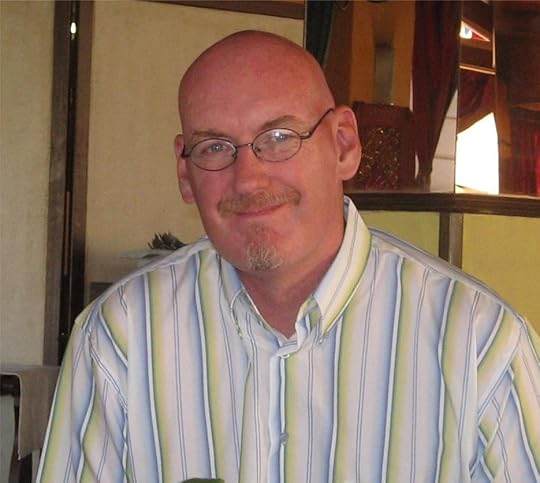 Tim Walker
Tim Walker
New Release from Daisy Wood
Today, I am delighted to feature the new release from Daisy Wood, The Clockmaker’s Wife. What’s more, I can highly recommend this WW2 story as I read the book recently and thoroughly enjoyed it.
The Clockmaker’s Wife
‘A ticking time-bomb of intrigue, wrapped around stark but rich descriptions of the Blitz. An unforgettable war-time debut.’ Mandy Robotham, author of The Berlin Girl
It’s the height of the Blitz in 1940, and too dangerous for Nell Spelman and her baby daughter, Alice, to stay in London. She must leave behind her husband, Arthur, one of the clockmakers responsible for keeping Big Ben tolling. The huge clock at the Palace of Westminster has become a symbol of hope in Britain’s darkest hour, and must be protected at all costs. When Arthur disappears in mysterious circumstances, Nell suspects evil forces are at work and returns to the war-torn city to save both the man and the country she loves.

Over eighty years later in New York, Alice’s daughter Ellie finds a beautiful watch with a cracked face among her mother’s possessions, and decides to find out more about the grandmother she never knew. Her search takes her to England, where her relatives are hiding shocking secrets of their own, and where she begins to wonder whether the past might be better left alone. Could her grandparents possibly have been traitors at the heart of the British establishment? Yet Ellie feels Nell at her shoulder, guiding her towards a truth which is more extraordinary than she could ever have imagined.
The Clockmaker’s Wife is available at all good book stores and online at: https://www.amazon.co.uk/Clockmakers-Wife-Daisy-Wood/dp/0008402302
A Little Bit about Daisy …

Daisy Wood worked as an editor in children’s publishing for several years before starting to write stories of her own. She has had over twenty children’s books published under various names, including the ‘Swallowcliffe Hall’ series for teens, based around an English country house through the years and the servants who keep it running. She loves the process of historical research and is a keen member of the London Library, which houses a wonderful collection of old magazines and newspapers as well as books. The Clockmaker’s Wife is her first published novel for adults. She studied English Literature at Bristol University and recently completed a Creative Writing MA at City University in London, where she lives with her husband, a rescue dog from Greece and a fluffy grey cat.
July 26, 2021
WW2: The Southampton Blitz
It is often the children who are most affected by war and WW2 was no exception. A poignant example of the terror experienced by a child is a quote from a young girl who survived the Southampton Blitzkrieg.
“There must have been some sort of warning before the sirens and when the barrage balloons went up, I knew it meant danger. I was very frightened. I used to rush down the garden to go headfirst into the shelter.”
Being within easy reach of German airfields in France, Southampton was an easy target for the Luftwaffe and a strategic one. Over the course of the war, 57 raids were carried out with approximately 2,300 bombs dropped. Six hundred and thirty one citizens were killed and 898 were seriously wounded. The damage was extensive with 45,000 buildings damaged or destroyed.
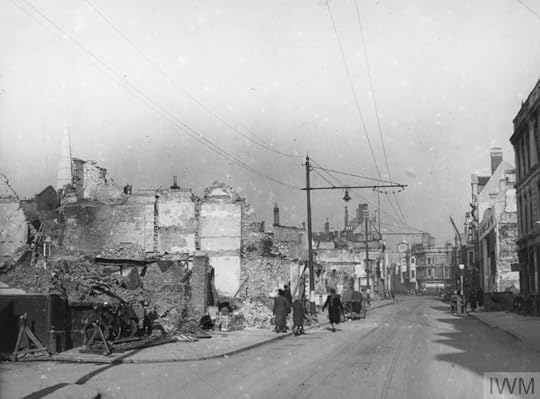 AIR RAID DAMAGE IN BRITAIN DURING THE SECOND WORLD WAR (ZZZ 8205C) Lower High Street, Southampton after the air raids of 30 November and 1 December 1940. Copyright: © IWM. Original Source: http://www.iwm.org.uk/collections/item/object/205022759
AIR RAID DAMAGE IN BRITAIN DURING THE SECOND WORLD WAR (ZZZ 8205C) Lower High Street, Southampton after the air raids of 30 November and 1 December 1940. Copyright: © IWM. Original Source: http://www.iwm.org.uk/collections/item/object/205022759Why was Southampton such an important target for Nazi Germany? Southampton was a busy naval port and Woolston was home to the Vickers Supermarine factory which was making Spitfire planes. The industry employed thousands of technicians and engineers. By 1940, production was at full capacity to meet the demands of the RAF who were desperate to replace the planes lost during the Battle of Britain. The factory was hit in September 1940, with much of the factory destroyed and 110 people killed. In the aftermath, Vickers Supermarine successfully dispersed its activities throughout Hampshire for the rest of the war, therefore making it difficult for the Luftwaffe to either find or destroy their works again.
Two dates stand out most due to the ferocity of the attacks. On the evenings of 23rd and 30th November 1940, there was such intensive bombing that the city’s water supply was ruined. Many of the fires, ignited by German incendiaries, had to be left to burn themselves out. The glow of the firestorm could be seen as far away as Cherbourg on the coast of France. The Nazis claimed they had left the city a smoking ruin as this American newspaper headline shows.
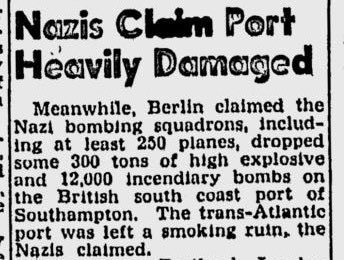
An earlier raid on 6th November, almost destroyed the city’s Art Gallery. The raid targeted the Civic Centre; as Hermann Goering head of the Nazi Luftwaffe had arrogantly observed – it looked like a ‘piece of cake’ from the air and he would ‘cut himself a slice’. In the course of the attack, 12 bombs were dropped including a direct hit with a 500lb high explosive on the Gallery. This bomb penetrated the roof, finally exploding in the basement killing 35 people including 15 children.
A tragic footnote: A gentleman by the name of Edgar L. Perry and his wife were killed on 23rd November 1940 in the Southampton Blitz. Edgar had worked as a coal trimmer on the doomed vessel, RMS Titanic, and had survived its sinking in 1912.
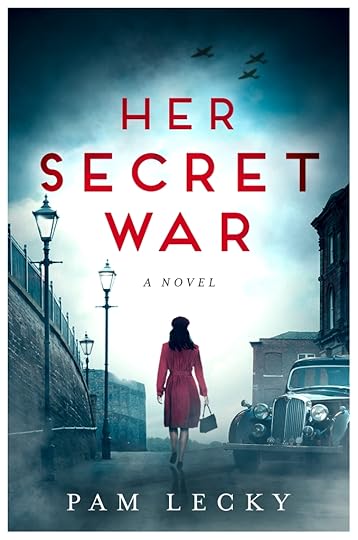
In Her Secret War, my heroine Sarah Gillespie arrives in Southampton and witnesses first hand the destruction wrought by the Luftwaffe the previous winter. However, Sarah finds the citizen’s defiance in the face of such adversity inspiring, giving her the confidence to follow through on her own pledge to thwart the Nazi regime in any way she can. Sarah begins work at Vickers Supermarine but, unfortunately for Sarah, her family’s dark past catches up with her and she is forced to take on a mission that could cost her life if she is to prove her loyalty to the Allies.
A Life-changing Moment – A Heart-breaking Choice – A Dangerous Mission
Her Secret War will be published by Avon Books UK/Harper Collins on 14th October 2021
Available to pre-order now: http://smarturl.it/HerSecretWar
June 18, 2021
New Release from John Anthony Miller
John Anthony Miller was born in Philadelphia, Pennsylvania to a father of English ancestry and a second-generation Italian mother. Motivated by a life-long love of travel and history, he normally sets his novels in exotic locations during eras of global conflict. Characters must cope and combat, overcoming their own weaknesses as well as external influences spawned by tumultuous times. He’s the author of seven historical thrillers and mysteries, as well as Song of Gabrielle. He lives in southern New Jersey with his family.
New Release
Normandy, 1216: Lady Gabrielle is captured at a French convent and taken to an English castle, a prize for Sir Michael Marston. Her lover, Montague of Rouen, allies with English barons plotting to overthrow their king. As England drifts into civil war, Montague attacks. Minerva, a powerful witch, casts a spell on Marston and Gabrielle, joining the two as one.
Montague fights with passion never seen before or since, and the castle begins to fall. Wrought with doubt, defined by desire, Gabrielle is forced to choose. With whom will she spend eternity: Sir Michael Marston or Montague of Rouen?
A romance thread through a world of war, fantasy fused with fiction, Song of Gabrielle is the tale of a woman who loves two men. Riddled with hexes, potions and spells, bound by love and honor, it defines the heart and all it holds, and the forces that try to control it.
May 30, 2021
The Night the Luftwaffe Paid a Visit to Dublin
Ireland was still recovering from the War of Independence from Britain and the Irish Civil War, when WW2 broke out in Europe. The government at the time, led by Eamonn de Valera, declared Ireland was a neutral country. Ireland had neither the manpower nor the resources to become involved in the conflict. Relations with Britain were already strained and Ireland’s stance made Churchill furious.
 Belfast Blitz
Belfast BlitzIreland’s neutrality, however, was tilted slightly in favour of the Allies. Downed RAF pilots were quietly escorted to the border with Northern Ireland, while their German counterparts were interned at the Curragh Camp for the duration of the conflict. Perhaps more significantly, the Irish government sent fire crews to Belfast, during the Blitz in April 1941, to help put out the raging fires and dig out the bodies. Immediately after, many Northern Irish refugees made their way to Dublin where they were warmly welcomed.
I grew up a few kilometres from the suburb of North Strand on the north side of Dublin City. As a teenager, I was astonished to discover I lived so close to the spot where a Luftwaffe pilot dropped bombs in the early hours of 31st May 1941. The events of that Whit weekend, echoed the Blitz of Belfast only weeks before, and the bombing of cities such as Liverpool and London, and indeed, many other cities throughout Europe. A taste of the Blitz must have shaken Ireland to its core.
Ironically, the war eventually forced the Irish and British governments to mend their relationship somewhat, even co-operating by sharing police and military intelligence. However, at the beginning of the war, Ireland was isolated, and technically at the mercy of both the Allies and the Axis countries. As a result, Irish people were nervous, particularly as a few stray German bombs had dropped on the city and in Co Wexford in the preceding months.
North Strand, located close to Amiens Street railway station, (now called Connolly Station) was a quiet location with a rural village feel. The locals had formed a close-knit community, something exceptional for an urban area so close to a city centre. The Luftwaffe squadrons, often 30 planes strong, regularly flew up the Irish Sea, skirting Dublin, on their way to bomb Belfast or Liverpool, and Dubliners were familiar with the drone of those Heinkel He 111 bombers. Often, on their way back from their raids, they would jettison their excess bombs into the sea to lighten their loads and save fuel for the journey home to their bases in France.
 Baldoyle Racecourse
Baldoyle RacecourseThe evening of Friday 30th May 1941 was a balmy one and Dubliners were looking forward to the bank holiday weekend. Some were planning day trips or just looking forward to relaxing at home with their families. Some would head out to Baldoyle Race Course for a flutter on the gee-gees. That night, the sky was incredibly clear. Blackout regulations were not strictly enforced in Dublin. There had been no clear ruling from Dublin Corporation, or ‘the Corpo’ as it was fondly known as by the majority of Dubs. Some advocated Dublin being fully lit, so the Germans knew the city was neutral; others favoured the safety of darkness. What they had was a ridiculous mix of the two.
Ireland had been relatively untouched up to then, bar a few stray Jerry bombs which the German embassy insisted were dropped in error due to faulty navigation. So, what happened that night?Something was different. Approaching midnight, instead of flying over Dublin, the German planes broke formation and circled the city. Searchlights illuminated the planes for the fascinated Dubliners who stood outside their houses, or in their gardens, watching the low flying bombers. What was going on? They normally flew over in formation, then disappeared.
 Formation of Heinkel He 111 Bombers: Attribution: Bundesarchiv, Bild 101I-408-0847-10 / Martin / CC-BY-SA 3.0
Formation of Heinkel He 111 Bombers: Attribution: Bundesarchiv, Bild 101I-408-0847-10 / Martin / CC-BY-SA 3.0Warning flares went up. That usually made Jerry move on. But not tonight. Then the anti-aircraft gun in Clontarf went into action. Things were getting serious. And still the planes lingered. The night sky turned into a light show, between the flares, searchlights and streaks of light coming from the shells. The citizens became increasingly anxious. And then, just as suddenly, the bombers left.
Or so everyone thought…Some time later, one plane appeared in the sky over the north of the city, ducking and diving and giving rise to alarm. Witnesses said he flew so low they could see his face. Was he looking for something in particular?
The first three bombs fell within minutes of each other, just after one thirty on the Saturday morning. Ballybough was hit first, with two houses demolished, but thankfully there was no loss of life. The second fell near the Zoo in the Phoenix Park, damaging Áras an Uachtaráin, the official residence of the president. The third fell near Summerhill, creating a huge crater in the road but miraculously, there were no injuries as a result.
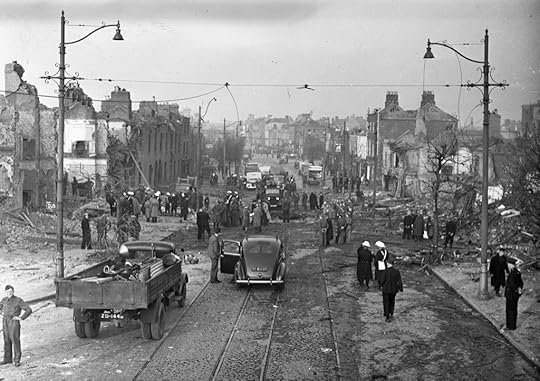 The North Strand the morning after the German bombing, on the night of 31st May 1941.
The North Strand the morning after the German bombing, on the night of 31st May 1941. (Part of the Independent Newspapers Ireland/NLI collection).
Used by kind permission from Independent News and Media, who hold the copyright for this image.
However, the fourth – a 500lb landmine, landed in the middle of North Strand, accompanied, according to witnesses, by a ‘dreadful screaming whistle’. Many were killed instantly, especially those caught out in the open; others would die later of their injuries. A gas main ruptured, but a quick thinking glimmer man burnt off the gas and prevented an even bigger disaster. The result of that landmine was the death of twenty-eight men, women and children. Ninety were injured and three hundred homes were decimated. As if the situation wasn’t bad enough, as the damage was assessed it became clear that many of the tenement-type terraces were too badly damaged and would have to be demolished. Four hundred people found themselves homeless. In fact, an entire suburb of Dublin was annihilated that night and would never recover. Some of those displaced by the destruction of their homes, were eventually re-housed in the outlying suburb of Cabra. North Strand as was, ceased to exist.
The grim business of recovering bodies began soon after.For days, bodies and injured victims were dug out to the horror of a country struggling to come to terms with a war which had been, before that awful night, over there somewhere in Europe. Now, it was most definitely impacting on their lives. The Red Cross and religious orders stepped in to help, funded by a generous and shocked public.
 Eamonn de Valera: National Library of Ireland on The Commons
Eamonn de Valera: National Library of Ireland on The Commons Five days later, on a wind-swept and rain-lashed day, the first of the funerals took place. The victims were buried in Glasnevin Cemetery, accompanied to their resting place by de Valera, politicians, emergency services and a vast crowd of grieving, ordinary citizens.
Dublin was a city in mourning.Pathetic scenes were witnessed as the cortege passed through the streets crowded with sympathisers … as the twelve hearses passed along women wept bitterly. (Evening Herald, 5 June 1941)
Soon after, the conspiracy theories flourished. Jerry did it deliberately because the Irish government helped Belfast during its Blitz; the British government was behind it, pretending to be Germans to drag Ireland into the war; the bombs were dropped in error due to faulty navigation or the pilot being disorientated … and on it went.
My opinion is, having read the eye witness accounts in Kevin C. Kearns’ book, The Bombing of Dublin’s North Strand, 1941: The Untold Story (ISBN-13 : 978-0717146444), that the pilot knew it was Dublin. It was a clear night, the city was lit up to signal it was neutral, they knew the route well, and the pilot flew incredibly low, described by some as if he were looking for a particular target. The bombers were fired on and I think that, combined with the Irish help given only weeks before to Blitzed Belfast, made that pilot angry enough to drop his payload. Of course, we will probably never know for sure. However, his actions were to have terrible consequences for the quiet enclave of North Strand. The official death-toll was twenty-eight, but many reckon it was nearer to forty-five as many bodies remained missing or never identified.
The aftermath …It wasn’t until 1958 that Germany admitted responsibility, without admitting guilt, and paid the Irish Government £327,000, against a total claim of £481,878. Most of the victims saw little of that money. The Corpo built blocks of flats on the derelict sites which had stood forlorn and forgotten for thirty years when I was just a nipper. And it wasn’t until 1991, that a memorial garden and plaque to the victims was put in place.
 Memorial to commemorate the bombing of the North Strand by the Germans during WWII:
Memorial to commemorate the bombing of the North Strand by the Germans during WWII:Photo Credit: UtDicitur
When I decided to write a WW2 novel, I wanted to anchor the story in Irish history. Coupled with inspiration from my family’s wartime experiences, the story of what happened that night in North Strand, seemed to me, a very good starting point. My heroine, Sarah, is lucky enough to survive but the events of that night change her life, forcing her to make incredibly difficult decisions.
For me, the destruction of a community is one of the most poignant aspects of the incident. The surviving residents were scattered throughout the city, never to return to their homes. The more I researched the bombing for my novel, Her Secret War, the more tragic I found it. So few people remember the events of that night now, and that is incredibly sad. Her Secret War’s opening chapters describe the events of that fateful night; a small tribute to those souls who perished.
Pre-Order now Available: https://www.amazon.co.uk/Her-Secret-War-Pam-Lecky/dp/0008464847
Her Secret War will be published by Avon Books UK/Harper Collins, worldwide, on October 14th 2021 and will be available in all good bookshops and online.May 22, 2021
New Release from Pauline Morgan
Retired housewife, Pauline Morgan, relocated to her native Northern Ireland. She has been writing since 2000 and decided to write about her experiences in various houses she lived in and, as a result, self-published the paranormal Special Houses. Pauline previously joined the Romantic Novelist Association and participated in their New Writers Scheme and she is also a member of an online writing group, Writers Ink VIP. Pauline has written four short stories which have been published in Woman’s Way magazine and a further two have been published in the iconic Ireland’s Own Magazine. She enjoys entering Flash Fiction competitions and was long-listed in the Kanturt Flash Fiction. Her first poem, Airborne, was posted on the Pendemic.ie website, in March 2020.

Pauline’s primary focus is on women’s fiction.
Her debut novel is about escape from mistrust, secrets and choosing between nosy friendships or loneliness, and was published by Spellbound Books on 21st May 2021.
Pauline, please tell us a little about your new release.My novel is The Ballynoon Friendship Circle, published by @SpellBoundBks. I wrote it about my experience of relocating to a village and joining a friendship group. Thus, the idea of writing about a friendship was born. I made up my mind to have an older protagonist to give her a second chance of finding love. The cosy story is about new beginnings, second chances and learning to lay the ghosts of your past to rest.
The reviews are going well on Amazon and Goodreads. Not forgetting the wonderful blog tour organised by @zooloosBookTours
If you would like to purchase a copy, here are the links:
May 6, 2021
New Release from Lizzie Chantree
Shh… It’s Our Secret, by Lizzie Chantree
Thank you for inviting me onto your blog today and for the amazing support of the launch of my latest book.
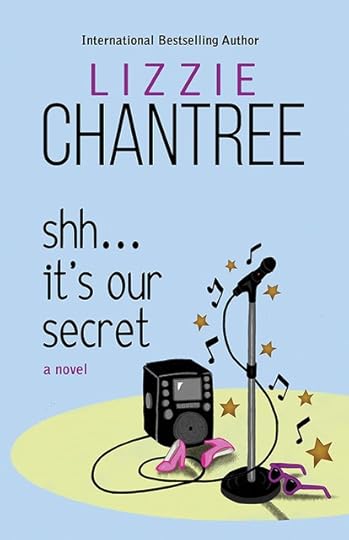
There are lots of ways to boost your mental health and wellbeing and having people around that you love and trust can help. In my latest book, Shh… It’s Our Secret, Violet struggles with self-confidence and self-worth.
She feels that her friends and her sister, all view her as a failure. The customers in the rundown café bar that she works in have become her confidants, including two eccentric pensioners, who feel like they have to act as her unofficial bodyguards when her secret ‘escapes’ into public knowledge. Violet will have to find out who has betrayed her and to step out of the shadows and find her voice.
Book Blurb:
Violet has a secret that could change the lives of everyone she knows and loves, especially the regulars at the run-down café bar where she works. After losing her parents at a young age, they are the closest thing she has to a family and she feels responsible for them.
Kai is a jaded music producer who has just moved outside of town. Seeking solitude from the stress of his job, he’s looking for seclusion. The only problem is he can’t seem to escape the band members and songwriters who keep showing up at his house.
When Kai wanders into the bar and Violet’s life, he accidently discovers her closely guarded secret. Can Kai help her rediscover her self-confidence or should some secrets remain undiscovered?
A little bit about Lizzie…International bestselling author and award-winning inventor, Lizzie Chantree, started her own business at the age of 18 and became one of Fair Play London and The Patent Office’s British Female Inventors of the Year in 2000. She discovered her love of writing fiction when her children were little and now works as a business mentor and runs a popular networking hour on social media, where creatives can support to each other. She writes books full of friendship and laughter, that are about women with unusual and adventurous businesses, who are far stronger than they realise. She lives with her family on the coast in Essex. Visit her website at http://www.lizziechantree.com or follow her on Twitter @Lizzie_Chantree https://twitter.com/Lizzie_Chantree.
 Lizzie Chantree
Lizzie Chantree

Book links: Lizzie Chantree.
Universal book buy link: The little ice cream shop: viewbook.at/IceCreamShopByTheSea
Universal book buy link: Networking for writers: viewbook.at/NetworkingForWriters
Universal book buy link: If you love me, I’m yours: viewbook.at/IfYouLoveMe-ImYours
Universal book buy link: Ninja School Mum: viewBook.at/NinjaSchoolMum
Universal book buy link: Babe Driven: viewbook.at/BabeDriven
Universal book buy link: Love’s Child: viewBook.at/Amazon-LovesChild
Universal book buy link: Finding Gina: viewbook.at/FindingGina
Universal link: Shh… It’s Our Secret: mybook.to/ItsOurSecret
Social media links:
Website: www.lizziechantree.com
Author page: https://www.viewAuthor.at/LizzieChantree
Twitter: https://twitter.com/Lizzie_Chantree
Facebook: https://www.facebook.com/LizzieChantree/
Goodreads: https://www.goodreads.com/author/show/7391757.Lizzie_Chantree
Instagram: https://www.instagram.com/lizzie_chantree/
Pinterest: https://www.pinterest.co.uk/LizzieChantree/pins/
FB Groups: https://www.facebook.com/groups/647115202160536/
BookBub: https://www.bookbub.com/profile/lizzie-chantree
LinkedIn: linkedin.com/in/lizziechantreeauthor
YouTube: https://www.youtube.com/channel/UCnCop-RlAcGqggZG3JfE-Mw
April 24, 2021
A Conversation with Anne McLoughlin
 Anne McLoughlinYou are very welcome, Anne, please introduce yourself:
Anne McLoughlinYou are very welcome, Anne, please introduce yourself: Born in Dublin, I now divide my time between there and my home in rural Wexford.
With my working life in television production with RTE behind me, I’ve now embarked on a new career in my retirement. Writing a novel was always an ambition, but until recent years I didn’t have a strong enough inspiration to spur me on, but that’s all changed now, since I had a brainwave.
Highly commended in the Colm Tóibín International Short Story Competition in the Wexford Literary Festival, this gave me the encouragement to really get stuck into working on my ‘Lives’ trilogy.
A 3-book deal with Poolbeg followed.
Which genre do you write in and what draws you to it?I didn’t choose a particular genre, I just sort of fell into Historical Fiction as my novels span a one hundred and forty year timeframe – from 1838 to 1978.
Researching my family tree led me to County Clare and the USA and during the process I uncovered fascinating stories. The inspiration for my books came from that experience and gave me a host of ideas for a fictional family tree series.
Are you an avid reader? Do you prefer books in your own genre or are you happy to explore others?I’ve always been an avid reader since I was about five years of age. A bit of a nerdy child, never without a book on the go. I’m a member of a couple of Book Clubs and I’ve read novels that I myself might never have chosen, but I’ve discovered some gems amongst others choices.
Are you a self-published/traditional or hybrid author?One of the good things that happened for me during the pandemic was getting the 3-book deal with Poolbeg Press. Kept me busy during lockdown which was great. I’m always one who has to have a project.
Has your country of origin/culture influenced your writing?Despite having been brought up in the city I’ve always felt very connected to the Irish countryside and nature. Setting my stories in rural locations feels for me as if the writing is coming from my soul, so it flows easily. I’d find it very difficult to write a city based book.
What part of the writing process do you find most difficult? How do you overcome it?I can’t write to order. For example writing on a theme, unless it is something that I feel strongly about or have experienced, I find that very difficult.
What was the best piece of writing advice you received when starting out?Don’t try and imitate anyone else. Find your own voice, it will come eventually. And keep writing every day, no matter how short.
If a movie was made of one of your books, who would you like to play the lead roles?For the part of Johanna I would cast Lola Petticrew as the young Johanna and Charlene McKenna as the older Johanna. Both are in the current TV series of Bloodlands. Great actresses and bear an amazing facial similarity to each other.
Johanna’s brother Hugh, the successful businessman and her troubled nephew Declan? I’m not sure. I think I’d have to audition a few lads for those parts.
You have been chosen as a member of the crew on the first one-way flight to Mars – you are allowed to bring 5 books with you. What would they be?They’d have to be books that I’ve not read before. Life is too short to read a book twice – too many still out there waiting for me to dive into. However, if I had to take my favourite authors, amongst them would be David Park and Kent Haruf, both beautiful sensitive writers who get right to the heart of the human spirit. Elizabeth Strout’s Olive Kitteridge would have to come so I can see what the bold Olive is up to next and Gail Honeyman’s Eleanor Olifant. Perhaps something by Kristen Hannah – always plenty of reading in her books.
Please tell us about your latest published work.My debut novel LIVES APART is a tale of emigration from Ireland to America after the famine. A family saga of betrayal, tragedy and survival.
It tells the story of young Johanna McNamara, who, in 1877 leaves her quiet life on the family farm in County Clare and emigrates to America to join her successful businessman brother Hugh.
Full of hope, she is determined to make a success of her life. However, tragedy strikes before she finds her feet in this new world, and she must put the care of others before her own needs.
Back in Ireland, farming life for the family continues through the seasons, with her brother Art struggling to deal with his troubled son Declan. Sending him to the USA is an option that might help turn him into a man. But little does Johanna know what lies ahead with the arrival of a nephew, whose act of betrayal will blow her life apart.
Set in Ireland, Boston, San Francisco and Nova Scotia ‘Lives Apart’ explores sibling relationships and how a disastrous action can reverberate through the lives of the extended family. It also looks at the experience of emigration, both for those who had the courage to venture across the Atlantic and those they left behind.
LIVES APART by Anne M. McLoughlin is the first in the ‘Lives’ trilogy, published by Poolbeg Press and is available as an eBook or Paperback from Amazon and Book Depository.
If you would like to know more about Anne and her work, check her out on Facebook:April 16, 2021
A Conversation with Derville Murphy
Hi everyone, delighted to talk to you all! I am a newbie author. But you know, I feel that it was inevitable I would end up writing novels. I started out as an architect – left the profession to study art history – fell in love with academia – and got hooked on writing. Now I am fortunate enough to be able to do what I really enjoy – I paint, and I write novels. I live in Dublin, I am married with two children and two adorable twin grandchildren.
 Derville MurphyWhich genre do you write in and what draws you to it?
Derville MurphyWhich genre do you write in and what draws you to it?My first novel, The Art Collector’s Daughter, was described as an historical psychological thriller. It moved forwards and backwards in time between World War 2 and the present day. It looks at Nazi stolen art and owning art objects – and what happens when this becomes an obsession. My second novel, If Only She Knew, was described as an historical drama. It was inspired by research I did into a Victorian artist written out of history because she dared to voice nationalist sympathies.
I was drawn to writing the book about the artist out of a compelling need to tell her story. History fascinates me, and I feel there is a need to look beyond the cold hard facts, and to try and really understand historical figures. But if I was to classify my genre, it would be art-related and not necessarily historical fiction.
Are you an avid reader? Do you prefer books in your own genre or are you happy to explore others?I read widely. I really like psychological thrillers, mysteries, crime anything that has a good plot and convincing characters. I particularly like novels that are centred on art. I don’t tend to read pure romance. I am currently reading, White Ivy, by Susie Wang about a Chinese girl whose dream is to assimilate into wealthy American society. It is written with a sharp wit and a keen eye on the insecurities of both cultures. On audible, I am listening to Shuggy Bain by Douglas Stuart, it is bleak, and desperately sad – a tale of poverty and addiction. Although it is wonderfully written, right now I feel like I need to immerse myself into something more uplifting. I am not sure I will finish it.
Are you a self-published/traditional or hybrid author?I currently have a three-book deal with Poolbeg Press for books distributed by Amazon as eBook and paperback. I suppose that is hybrid.
Who has been the biggest influence on your writing?Douglas Kennedy, Jessie Burton and Kristin Hannah.
Has your country of origin/culture influenced your writing?I lived in England till I was thirteen, then moved home to Ireland. Being Irish in England, then being the English girl in Ireland has meant I am invested in both cultures. Although my novel, If Only She Knew is predominantly from an historic Nationalist perspective, it also sees those times through English eyes.
What part of the writing process do you find most difficult? How do you overcome it?Starting off – thinking that I am going to spend the next year or so doing this. I suppose, I find it hard to commit to a story. I try to get over this by focusing on subjects that I am interested in, that I want to learn more about. In that way, hopefully, the book is also a journey for me as well as for the reader.
What was the best piece of writing advice you received when starting out?When you think you have finished your novel, you have only started. Leave your book for three months and then come back to it – then edit, edit and edit again.
Do you have a favourite time of day to write?Yes, six o’clock in the morning. My mind is crystal clear then. By lunchtime, the fog starts to drift in!
If you weren’t an author, what would you be up to?I was working as an art consultant before my first novel was published, and I enjoyed that very much. But I don’t have time for it at the moment. If I wasn’t writing novels I would probably be painting. I work in oils mostly and usually have an art project on the go while I am writing. For, If Only She Knew, I did a series of paintings investigating different aspects of the artist’s life.
If a movie was made of one of your books, who would you like to play the lead roles?I always thought that The Art Collector’s Daughter would make a great Netflix thriller. I would suggest Nicole Kidman as the artist Sylvie Vasseur, and Ralph Fiennes would make a brilliant bad guy, Nicholas Courtney.
If you could live the life of an historical figure for one day, who would you choose and what would you get up to?I would be Leonardo da Vinci’s studio assistant, and spend the day talking to him to understand his extraordinary vision as an artist and inventor.
If you could travel back in time, what era would you go to? What draws you to this particular time?I would certainly enjoy being alive at the end of the Victorian era. it was a time of rapid change, industrially, intellectually, and artistically. Provided of course, that I was born into a wealthy, liberal family and I didn’t have to wear corsets. [Pam: Ha-ha; I don’t think the corsets were optional, unfortunately!]
You have been chosen as a member of the crew on the first one-way flight to Mars – you are allowed to bring 5 books with you. What would they be?They would be James Joyce’s Ulysses, (at least I might get to finish it); The Complete Works of Shakespeare; Seamus Heaney’s New Selected Poems; Jane Austen’s Pride and Prejudice, and E.H. Gombrich’s, The Story of Art.
Please tell us about your latest published work.If Only She Knew described as, ‘Peaky Blinders meets Pride and Prejudice’, is an historical drama set between the art and criminal worlds of Dublin and Manchester. Wilful and spirited, Julia Benson, is disinherited by her father – and forced to be financially dependent on her sister’s controlling husband. When Julia’s Fenian lover goes missing, she tries to find him and unwittingly becomes involved in a plot so dangerous that it could destroy her life, and any chances of Irish Home Rule forever.
Buy Links: If Only She Knew is published by Poolbeg Press and is available as an eBook and paperbackSOCIAL MEDIA LINKShttps://www.dervillemurphyauthor.com
https://www.facebook.com/derville.murphy
https://twitter.com/DervilleMurphy
April 14, 2021
New Release from Tony Riches
Robert Devereux, Earl of Essex, is one of the most intriguing men of the Elizabethan period. Tall and handsome, he soon becomes a ‘favourite’ at court, so close to the queen many wonder if they are lovers. The truth is far more complex, as each has what the other yearns for. Robert Devereux longs for recognition, wealth and influence. His flamboyant naïveté amuses the ageing Queen Elizabeth, like the son she never had, and his vitality makes her feel young. Robert Devereux’s remarkable true story continues the epic tale of the rise of the Tudors, which began with the bestselling Tudor trilogy and concludes with the reign of Queen Elizabeth I.

Amazon US: https://www.amazon.com/dp/B09246T7ZT
Amazon UK: https://www.amazon.co.uk/dp/B09246T7ZT
Amazon CA: https://www.amazon.ca/dp/B09246T7ZT
Amazon AU: https://www.amazon.com.au/dp/B09246T7ZT
Tony Riches is a full-time UK author of best-selling Tudor historical fiction. He lives in Pembrokeshire, West Wales and is a specialist in the history of the Wars of the Roses and the lives of the early Tudors. Tony’s other published historical fiction novels include: Owen – Book One Of The Tudor Trilogy, Jasper – Book Two Of The Tudor Trilogy, Henry – Book Three Of The Tudor Trilogy, Mary – Tudor Princess, Brandon – Tudor Knight and The Secret Diary Of Eleanor Cobham.
For more information about Tony’s books please visit his website tonyriches.com and his blog, The Writing Desk and find him on Facebook and Twitter @tonyriches
